Digital Canvas: Layer Tennis
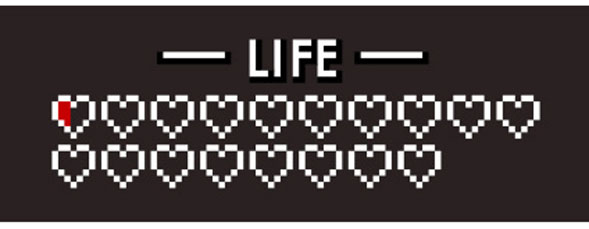
In lieu of our typical “Digital Canvas” in the September/October 2009 issue of Layers, we decided to show you the volleys from the final round of Layer Tennis (formerly Photoshop Tennis) and talk to the finalists. Presented by Adobe Creative Suite 4, Layer Tennis (www.layertennis.com) is a series of online design events where creative pros send files back and forth in real time. Each match consists of 10 volleys, with each volley lasting 15 minutes. Spectators have the opportunity to watch, post commentary, and vote for a winner after each match via Twitter. On July 10, 2009, Greg Hubacek went head to head with Shaun Inman in the final match. In the end, Inman won the popular vote and was declared the champion.
Layers: Before we jump into the volleys, can you provide just a little background about yourselves, including what inspires you and what type of design you specialize in?
Hubacek: I’m a designer living and working in the Twin Cities (Minneapolis specifically). I’m freelancing currently, but I’ll be starting as a Senior Designer at Space 150 in Minneapolis by the time anyone reads this. I’ve kind of always wanted to be a designer, and I’ve never really looked back. It was a bit of an easy decision for me. It’s a long story as to how I got here but I don’t think I’ve ever really thought that I shouldn’t be doing what I’m doing.
I don’t really specialize in anything—I try to take on a wide range of projects. It’s most interesting for me to be constantly learning and expanding, doing something I haven’t done before. Right now I’m working on a music video, a couple identity systems, a website, some apparel, print work—the balance is what keeps it exciting and fresh. It’s what makes me wake up and put on some coffee in the morning.
Inman: I received a degree in Graphic Design at the Savannah College of Art and Design. I’m a self-taught client- and server-side developer. I also dabble in iPhone game development. I’m originally from the Boston, Massachusetts, area; spent a few years in Baltimore, Maryland, after graduating from SCAD; and currently reside in Chattanooga, Tennessee.
I’ve been self-employed since the launch of Mint in 2005. Since then I’ve been designing, developing, and selling my own Web-based products under the novel moniker “Shaun Inman” (which appears as “Shaun Inman Design & Development, Inc.” on tax forms and customer credit card statements).
Oddly enough, CD packaging, especially the early Nine Inch Nails singles and EPs (Sin and Broken immediately come to mind), is what inspired me to get into design. That and a high school art teacher who proclaimed that my work was very graphic. The next day (or not long after) a representative from SCAD visited the school to promote their various programs including graphic Design. One naïve internal game of connect the dots later and my fate was set. (Looking back on my high school art now, I think “graphic” was just a nice way of saying that I needed to work on building volume in my pencil drawings.)
Order inspires me: systems, hierarchy, attention to detail, grids. I have a tendency to rebuild the systems I use daily that don’t work for me. Mint and Fever are both products of examining existing data-heavy systems (Web stats and feed readers respectively) and regimenting an ordered, modular design for ergonomic data consumption.
I’d have to say my specialty is system design. I see myself as a jack-of-all-trades (and as a result, a master of none): design, development, music composition, copywriting, customer support. My penchant for pixels of the big blocky variety has also become notorious on the Layer Tennis circuit lately.
Layers: How do you think Layer Tennis resonates with the design community?
Hubacek: I think there are a lot of people who follow it for entertainment value, and there’s something great about getting to watch people do something live. The experience of being a designer is somewhat universal as far as being under pressure and having short timelines. Layer Tennis just exaggerates that and puts it under a microscope, so it’s easy to see why it would attract other designers.
Inman: Working in the creative industry is stressful with its tight deadlines, a surprising lack of creative flexibility for all but brand-name designers, and very little extra-industry praise for what we do. Layer Tennis is a celebration and parody of all these things and a nice respite for a Friday afternoon—as long as you’re not the one playing.
Layers: How did you prepare for this season’s matches? Did you have any overarching strategy going in?
Hubacek: Every match was different; you don’t prepare the same way for every match. For some matches I had a selection of tools available, for others I was more prepared. The match against Shaun was very spontaneous. I don’t think either one of us played our best game, but it was in the true spirit of Layer Tennis. I had a few typefaces and some other things ready to go but for the most part it was a pretty responsive match for me.
Inman: I didn’t actually participate in this most recent season until the postseason playoffs. Because I launched Fever the same week the playoffs started, I didn’t have much time to prepare for anything. Unless firing off scores of support replies per hour in the days leading up to each match counts. Generally, my fallbacks include puns, word or style association, and exploring the bounds between volley and the page that contains it. And more recently, references to 8- and 16-bit video games.
Layers: What Adobe tools did you use in the final? Were there any features you used that helped save time?
Hubacek: Flash, After Effects, Photoshop, Illustrator. I think that was it.
Inman: I stuck to Photoshop for the majority of my volleys, occasionally using Flash to animate flattened frames exported from Photoshop and add audio loops. As far as features go, gimme the Marquee tool and Opacity and Multiply layer effects and get out of the way.
Layers: So Inman, how does it feel to be the champ?
Inman: That’s a hard one to answer. Mr. Miyagi is the real champ. He taught Daniel-san everything he knows. He took a skinny little kid and made a World Champ out of him. If Daniel-san had any other instructor or trained any other way he wouldn’t have been able to defeat Cobra Kai.
Volleys

Tools used: Click image for animation
Volley 1
Layers: Do you think there’s an advantage to going first in Layer Tennis, and why did you start with such a subtle serve?
Inman: The obvious advantage is having a little more time to think about and work on your serve. Rather than use that time to overproduce an elaborate design, I opted to create something simple that encouraged viewers to interact with their physical displays to bring them into the game. I also thought the largely white-on-white design would allow us to focus on the layers part of Layer Tennis. Besides, everyone loves spot varnish.

Tools used: Click image for animation


Volley 2
Layers: Why did you decide to play along with Inman? Did you think Tiffany would get stuck in your opponent’s head?
Hubacek: Honestly, how do you return a volley like that? I was hard-pressed to do anything after wasting half my time trying to figure out what Shaun’s layer said. Once I realized what it was, I just sprang up with the first response that I could think of. Shaun hadn’t given me much to work with, so an equally minimal response seemed fitting. The Tiffany reference is continuing off of his “Are the New Viewers Gone Yet?”, as in “Yes, I think we’re alone now” (you’ve scared off all the first-timers) “the beating of our hearts is the only sound.” I totally missed his Mr. Show reference. The heart was really the only new piece I left him with; that and the curse of having Tiffany stuck in his head.
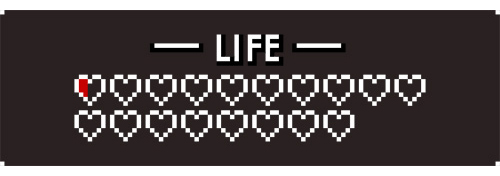
Tools used: 
Volley 3
Layers: Does the remaining half heart straight out of Nintendo’s Zelda video game represent how you feel about your opponent or about Tiffany?
Inman: The half-a-heart remaining was definitely a taunt in response to what felt like a halfhearted return. I just couldn’t muster a pixilated parrot (“Polly want a layer?”) within the 15-minute time limit. Too bad I fell prey to the same thing I was mocking the previous image for: not moving the conversation forward.
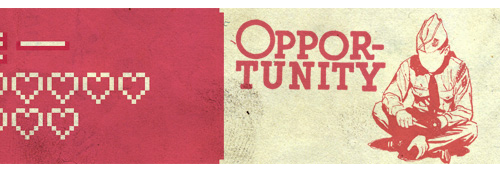
Tools used: 

Volley 4
Layers: What the heck is wrong with this Boy Scout?
Hubacek: Nothing’s wrong with the Boy Scout. He’s faceless; I guess that’s weird. But that’s really harsh of you to judge him for that. He obviously has larger issues to deal with, like his loss of his left hand, which seems to be the result of a wood-whittling accident. It’s a bit of an outside shot at the ideas of having an opportunity to make something but instead causing irreparable harm to oneself. Like opportunity lost.
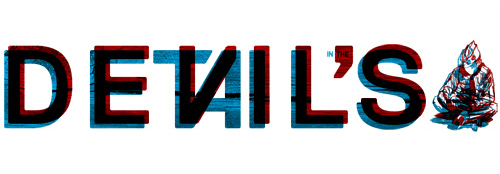
Tools used: 
Volley 5
Layers: How did you come up with this type trick on the fly?
Inman: I noted the shared characters in “devil’s” and “details” while brainstorming my serve the night before. When Greg replied with the inattentive whittling Boy Scout, I knew exactly what to do. The “TA” ligature and custom “V” are just a modified reversed “N.” Initially, I didn’t overlap the text. As a result, the observation I was trying to make ended up being too subtle. Finally, I took a quick photo of our weathered deck for the wood grain texture and had my most successful, least painful-to-birth volley of the postseason.
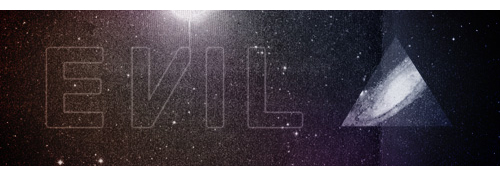
Tools used: 

Volley 6
Layers: A self-mutilating Boy Scout and now evil permeating the universe—is there something you’re trying to tell us?
Hubacek: I really had no idea what Shaun was trying to say with the last volley. It was a nice type trick, but I didn’t really feel like we were finding a rhythm at all. I couldn’t find much conceptual continuity between the last round and this one, and I really wasn’t sure what he was referencing with the line. Curveballs can be the hardest to hit, so I decided to send him one back. If the devil is in the details and there are details everywhere, then the whole world must be evil—and have the same awkward kerning.
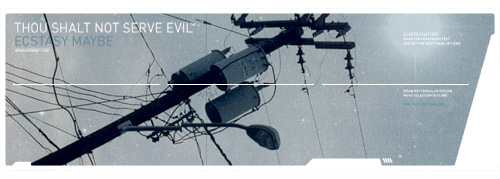
Tools used: 
Volley 7
Layers: You picked up the word “Evil” and the field of stars from Hubacek’s previous volley. How did these elements inspire the rest of this volley?
Inman: Honestly, the Evil Galaxy had me at a loss so I picked an aesthetic I was comfortable with (late ’90s Web and rave flyer design) and did what I could with existing elements from the previous volley. Prerequisites: Desaturated Images 103, Irrelevant Microtypography 201, and Diagonal Die-cuts 404.
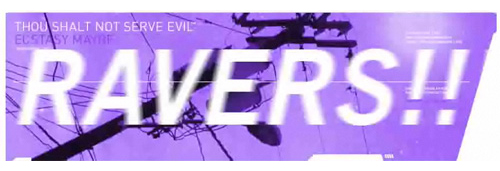
Tools used: Click image for animation



Volley 8
Layers: So did you feel that victory was at hand and you were all geared up to party, or is there a deeper hidden meaning to the word “Ravers” here?
Hubacek: No, actually the raver thing is a reference to the notchy-spacey-rave flyer play of Inman’s seventh round. It was a bit of a sophomoric joke that when coupled with the hour it took to get the video up fell with a bit of a thud.
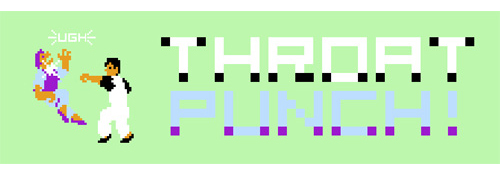
Tools used: Click image for animation

Volley 9
Layers: It seems that you’re still bitter that Hubacek planted that Tiffany song in your head. What was it about this piece that you thought would deliver the knockout punch?
Inman: This image is a direct response to two things: the final word at the very end of the previous volley—after all those “Ravers,” a single “Ugh”; and the commentators’ early match expectations of more throat-punching designs. Delivered literally. The surly fighters and quirky chiptunes also serve to recall the final volleys of my previous Finals matches.
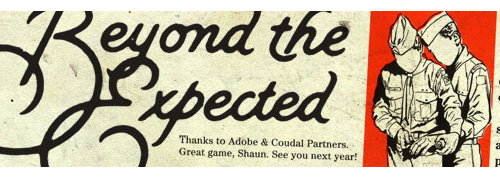
Tools used: 

Volley 10
Layers: Inman just punched your design in the throat. Why did you go “Beyond the Expected” and do what appears to be lending a helping hand to your opponent?
Hubacek: It’s not about who punched whom in the throat. This is the last layer of Layer Tennis 2009. As someone who came into the finals from the back of the field of qualifiers, I’m not mad at the throat punch. The people were calling for it, and I am certainly no stranger to spilling blood for the people’s amusement. I’m honestly just happy to have been here. It was a strange match, and the whole season was beyond what I could have expected from being involved with Layer Tennis. This last one was about just saying that at the end of the day, it’s all just theatre. I have a lot of respect for Inman, Draplin, Glass, and all the other Layer Tennis players from the year. All wounds are bandaged—no harm done—first round of drinks is on me.


